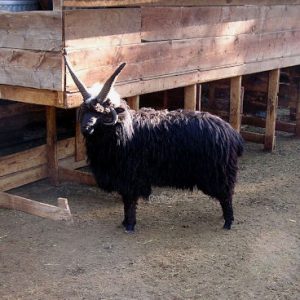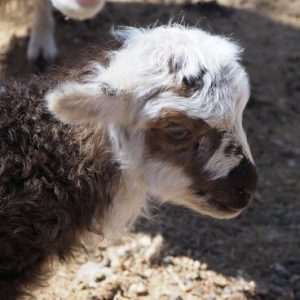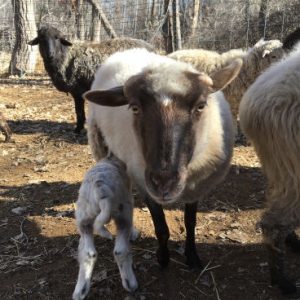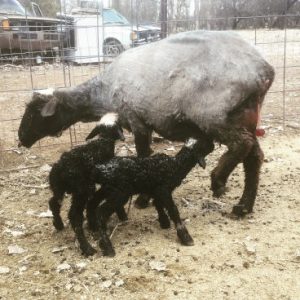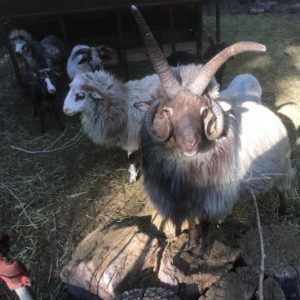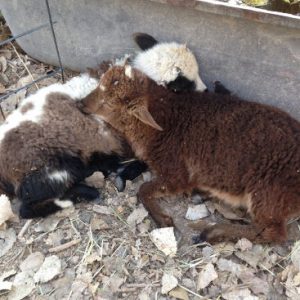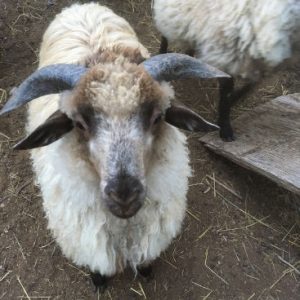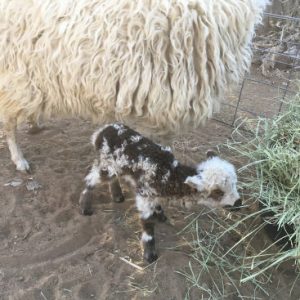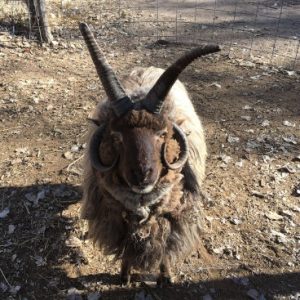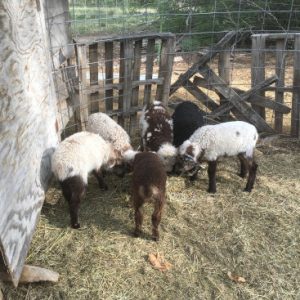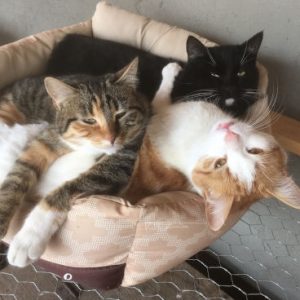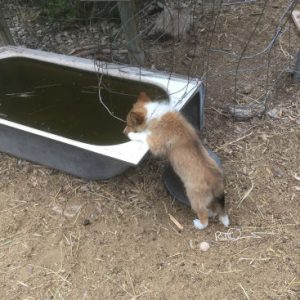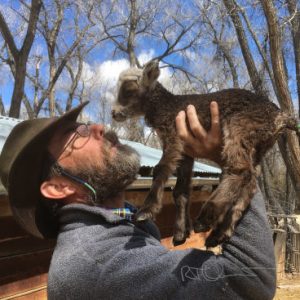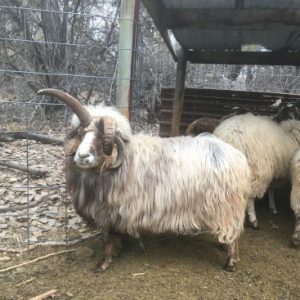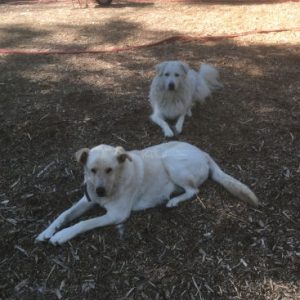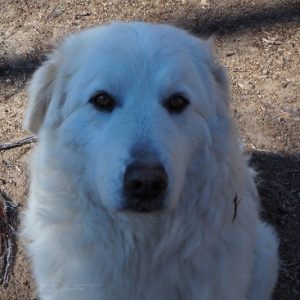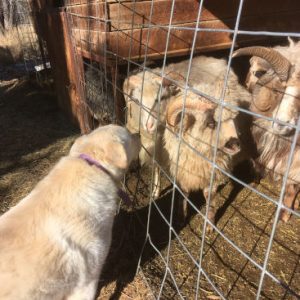Navajo-Churro Sheep
Navajo-Churro sheep can walk a long way in a day
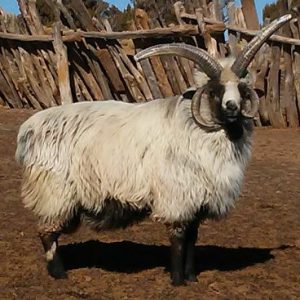
Navajo-Churro sheep are descended from the flocks brought to this continent by the Spanish explorers starting in the 16th century*. They have a long, non-greasy, non-crimpy, double coated fleece. The fleece will have relatively large diameter fibers (coarse), and very fine fibers. The outer coat is the big fibers, and the fine fibers make up the undercoat. The handle of the fleece can vary widely from coarse feeling like steel wool to soft and silky. From dry and chalky to lustrous and smooth. This has created some confusion about what Navajo-Churro wool is, but we just have to own the fact that it is all churro. There are colors: after 35 years I am still getting colors I have not seen before. These sheep can walk, and by that I mean a long way in a day. This is probably the main reason the Spanish brought this type of sheep with them. They can tolerate the heat and the cold, forage in sparse range, and give birth on their own to strong lambs that can keep up with the flock.
These are sheep with personality, and they are, as a group, difficult to describe precisely because they each have their own personality. Most ewes and rams are alert, curious critters who are not great at figuring out stuff on their own. They don’t really want to be touched by the shepherd, but they don’t run away, either. The instinct to flock together is very strong, and they will usually try desperately to return to the flock if they get separated.
Then there are some characters. There are friendly sheep, clowns, and a few that are wild as deer. There are very smart ones that open gates, and some that really can’t solve the simplest problem. There are a few, mostly rams, that are truly mean, and, if they are the smart kind, will bide their time and then try to kill you. For this reason any ram that shows the least tendency to fight with the shepherd must be killed sooner rather than later. There are rams that are just wild and must not be cornered. I have had a full grown ram jump exactly over me. These should probably be killed also because they are so hard to handle and could also injure the shepherd. (Word of advice: Do not make a pet of a ram. He will grow up and want to play and fight with you, so don’t.) Fortunately, MOST rams are at least peace-loving, and occasionally, true gentlemen. A truly mean ewe is not so much of a threat to you, but will go after your dogs, and may injure lambs that are not her own. Fortunately these are rare. Then, there are the runner sheep. These escape artists will amaze you with their abilities to get out, get gone, and evade capture. They seem to prefer to work in pairs. They are a pain in the ass.
There will emerge a leader in your flock. She will most likely be a ewe, and if you are lucky she will be a calm, friendly, and wise leader who will be a great help in managing your flock. She will lead them from danger and back to the sheep pen or to you directly if you are near. On a hot day she will put them down for rest in the shade and get them out again if clouds cover the sun. She will lead them home in the evening. I have had three leaders like this in my flock, and I tend to keep them until they are very old. I have also had two leaders emerge from the wild side, and I can tell you the rodeo index went through the roof. A wild leader keeps the sheep away from you and will defend them. If she gets the chance she will try to take the flock to Mexico or maybe Canada. One of these ladies stampeded the flock right through/under/over me to get away. You can see that this behavior could be good for a wild flock trying to get along in the mountains, but here in a farm setting it is not good at all. I learned from the wild leaders then removed them from the flock.
Probably the most confusing thing, and maybe the coolest thing about Navajo-Churro Sheep is the diversity present in the flocks. There are tall sheep with long bodies, short strong sheep that look like they are one or two vertebra short of a full deck; sheep that grow an eight-inch fleece in six months, ones that hardly grow wool at all; polled sheep, sheep with up to six horns; long floppy ears, short little ears; soft silky wool, coarse scratchy wool; all kinds of colors, piebald, tricolor, you name it. How do you sort this out? Well, to me the main focus is the wool. I am a spinner and a weaver and I have come to love the softer, silkier, more lustrous wool that some of these animals produce. I select my breeding animals from this group and look for fast wool growth so I can shear twice a year–less time on the animal equals less damage from the sun and wear and tear– and try to always improve the color diversity in the flock. After 35 years I am getting a lot more of what I want to see from my sheep, but I still get animals that don’t measure up. Reversion to the mean (look that up if you’ve never heard it before) is a real factor in diverse populations, and is a big factor in working to get what you want out of these sheep. On the other hand, there is a lot to choose from. I think we breeders of Navajo-Churro sheep should embrace the diversity while still trying to breed for that particular sheep that we feel is the most Churro of the Churros. Every one of us breeders has a different ideal sheep, and this will help maintain the diversity in the flocks, while moving them down the road in the direction of the breed standard.
One thing that has come obvious to me over the years is that for a flock of Navajo-Churro Sheep to be meaningful and useful, they must be managed to a purpose that serves the shepherd. And the more diverse that purpose is, the more meaningful a flock will be. There are still Navajo people who care for their sheep in the traditional way that was handed down to them from their elders. They still follow the sheep, sell them, trade them, butcher, cook, tan pelts, shear, spin the wool, and weave the blankets. I do this as well. When this type of shepherding is gone, and it very nearly is gone, the meaningfulness, the usefulness of these wonderful sheep, will also be gone.
By 1986, the Navajo-Churro Sheep Association was formed to preserve and promote this truly All-American breed.
